We often think of food as energy, but it isn’t. Food is information and food is fuel. Our bodies create energy by using the fuel we put in it. That same fuel in turn informs the expression of your DNA. It’s the main reason why food choice is so important. Food is a more powerful medicine than anything you’ll find in a pill bottle, yet for many it’s the bottom of the priority list leaving them starving on a full stomach.
A lot of foods and eating patterns rob the body of energy. We also need specific types of food at specific times to support our body’s energy systems and most popular eating patterns don’t factor in what’s needed to allow you to experience vitality to the full. In their food demo at London’s Love Natural Love You consumer show this weekend, scientist Rob Verkerk PhD and nutritional practitioner Meleni Aldridge demonstrated the 5 steps required to light up your body’s energy systems.
We share a synopsis of the simple principles they delivered to a standing room only audience last Sunday 10th July.
The 5 steps in brief
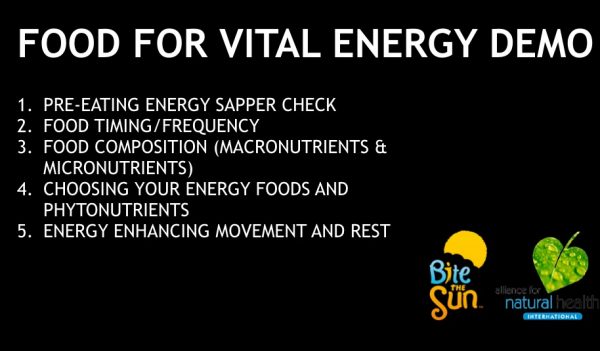
Step 1

Foods you love may not love you back quite as much. If you’re living with symptoms like digestive discomfort, mucous build up, headaches, loss of energy, recurrent sneezing, acid reflux or irregular bowel movements, you may well be suffering with an intolerance or sensitivity to one or more foods you regularly eat. Figuring out which foods are the worse offenders may be obvious from the reaction after a meal, but gluten (in wheat, barley, spelt and rye) and dairy are two of the most common. Eating foods to which you’re intolerant drives varying degrees of inflammation that not only ups your risk of chronic disease, but also saps your energy as the immune system takes control of the lion’s share of the fuel you take in.
Food additives and non-nutritive, new-to-nature chemical ingredients, for technological rather than nutritional function, add nothing to the functional element of food. They also are likely to be responsible for making your liver and detoxification systems work overtime, which creates another unnecessary energy demand.
Make sure that your diet includes a diverse range of plant foods to give you ample fibre and protective phytonutrients. Remember that food is information that drives the expression of your genes, it’s also fuel to make vital energy. Responding to hunger with a processed ready-meal of macaroni cheese or a plate that includes a rainbow of coloured vegetables, fresh herbs, spices, healthy fats and quality protein speaks a vastly different language to the body. It’s not just you you’re feeding – you have a trillion bacteria that are also sharing your meal with you. Get them offside with your meal choices and your health, your vitality, your state of mind and your longevity will suffer!
Step 2
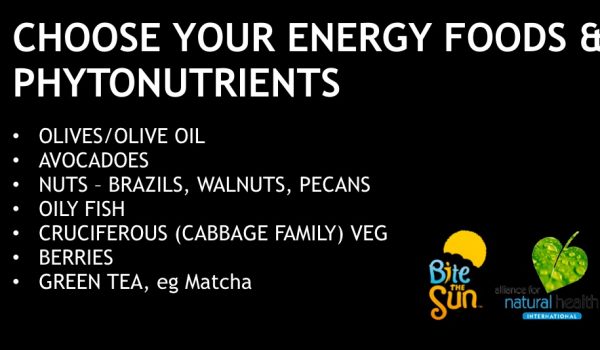
Making changes in your diet need not be overly stressful. A lot can be done with small steps and bringing in one new food a week, focussing especially on those foods that support our energy systems. In our presentation we singled out 7 specific foods that could be regarded as energy superfoods:
- Olives/unfiltered extra virgin olive oil – olives are actually fermented foods when bought in brine, and being fermented help nurture your all important gut microbiome. Unfiltered extra virgin olive oil is also rich in hydroxy tyrosol which helps support the development of new mitochondria – the energy factories in your cells.
- Avocadoes – a fantastic source of healthy, primarily saturated, fat which provides more than twice the energy of a comparable amount of carbs or protein.
- Tree nuts – Brazil nuts are rich in selenium that is a co-factor in our energy-yielding metabolism whilst walnuts have been demonstrated to be a brain and body superfood.
- Oily fish – a great source of high quality protein and omega 3 polyunsaturated fatty acids that help manage a healthy inflammatory response and keep the immune system well modulated.
- Cruciferous vegetables – includes all members of the cabbage family ranging from cabbages, broccoli, cauliflower, kale, rocket, collard (greens) and a wide range of Asian vegetables such as pak choi, bok choi and Indian mustard. These veggies contain compounds that help support detoxification, as well as managing DNA repair, and so reduce our overall risk of cancer.
- Berries – a very rich source of polyphenols that are among the most important natural antioxidants consumed in our diets. These compounds help to offset the damaging effects of unquenched free radicals that otherwise lead to oxidative stress and damage to membranes, DNA, cells and tissues.
- Matcha green tea – the benefits of catechins, especially EGCG, have been widely extoled. But with matcha we get a double whammy as the concentrations of these beneficial compounds tend to be higher as we consume not only the water infusion from fermented green tea leaves, but actually the tea leaves themselves in powdered form.
Step 3
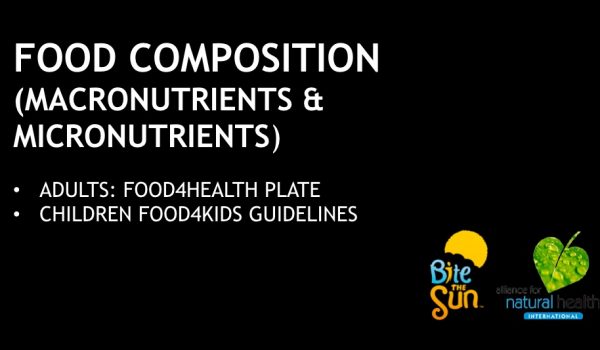
The complete low down on the ANH-Intl adult Food4Health Plate
And the Children’s Food4Kids Guidelines
Step 4

From an evolutionary perspective, it’s clear that we are built for famine and not for feast. Our protective mechanisms against disease are adapted to starvation, or what we now think of as ‘intermittent fasting’ (i.e. NOT eating little and often, NOT eating three meals a day with snacks in between). Without food, we can actually use ketone bodies produced by burning (beta-oxidation) our own fat deposits as our primary fuel for energy. This can be achieved with a low carb, relatively high fat, ketogenic diet, such as that consumed when you follow the ANH Food4Health Plate.
Your food timing is as important as your food frequency. In our bygone hunter-gatherer days there were no fridges at the end of the hall or corner shops at the end of the street. No, we had to get out there and be active to find food before we could eat it. So it’s no surprise to find that our bodies respond well to being active in a fasted state and going a prolonged period between meals. Once adapted – and this metabolic adaptation phase can take around 8-12 weeks – your body will reward you with additional energy, brimming vitality, reduced inflammation, a clear head, enhanced concentration and a leaner body. It’s not rocket science. We needed these attributes to survive and protect our young, to outwit our predators, find food and have sufficient energy for our nomadic lifestyle.
When you start to follow a more evolutionary-rational eating pattern you often find that 3 meals a day is too much food for you. Most often people choose to drop breakfast and go for a long fast from dinner the night before through to lunch the following day. In our view this is one of the easiest ways to mimic an eating pattern that is more easily recognised by our genes, yet fits into our modern lives. Controversially, breakfast becomes the most important meal of the day to drop! But this isn’t so irrational when you look at our evolutionary heritage and what our bodies are best adapted for. It’s ideal if you can include some form of activity before you eat lunch after your long fast to trigger those metabolically protective pathways.
Step 5
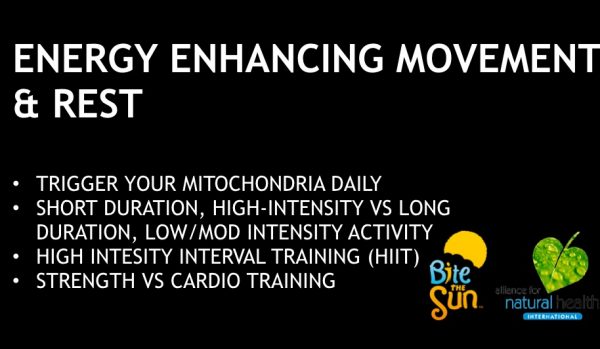
Nutrition is key but it’s not the sole player. Physical activity is increasingly recognised as being at least as important. By improving both our nutrition and our movement, we’re able to gain from synergy, which is enhanced further by paying attention to sleep, rest and relaxation. While we understand the importance of eating and sleeping each day, not everyone has got the message that it’s equally important to trigger your mitochondria each day. That can be through very short bursts of activity, whether it’s climbing stairs two at a time, doing some squats or lunges in your office or engaging in some High Intensity Interval Training (HIIT). It’s very important to also include some low to moderate intensity activity over longer periods, that helps you become a better fat burner. You should focus on resistance activity that builds your strength and power, as well as your cardiovascular system with lower intensity, longer duration activity. These generally shouldn’t be done together, and if they have to be combined, always do the resistance work before the cardio work to help prevent you from metabolising precious muscle.
In summary… here are the main points again
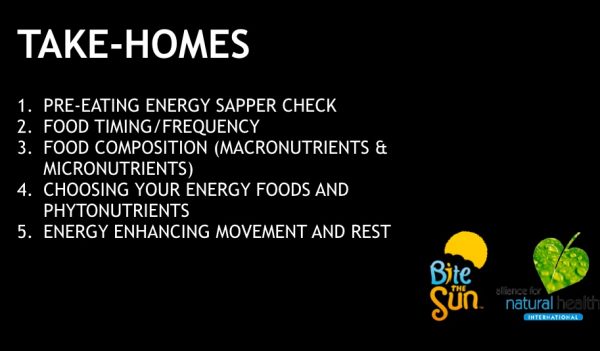




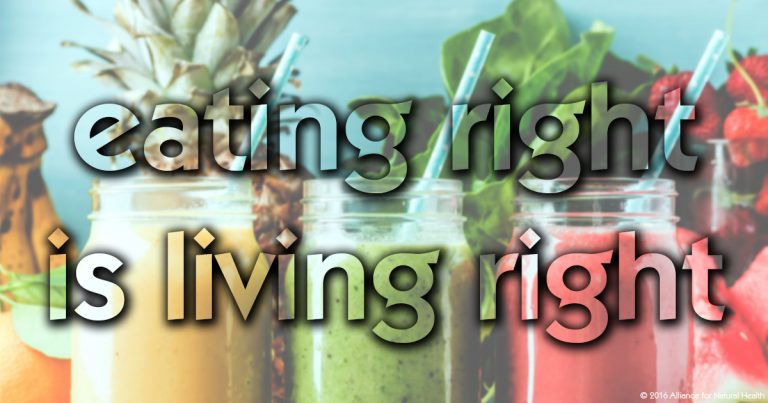



Comments
your voice counts
There are currently no comments on this post.
Your voice counts
We welcome your comments and are very interested in your point of view, but we ask that you keep them relevant to the article, that they be civil and without commercial links. All comments are moderated prior to being published. We reserve the right to edit or not publish comments that we consider abusive or offensive.
There is extra content here from a third party provider. You will be unable to see this content unless you agree to allow Content Cookies. Cookie Preferences